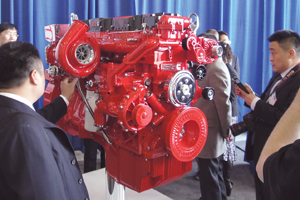Cummins Showcases Engine to Power New Chinese Truck

This story appears in the April 14 print edition of Transport Topics.
COLUMBUS, Ind. — For one day, the center of the Chinese truck universe was this southern Indiana town more than 6,700 miles from Beijing.
It was here April 8 that Cummins Inc. and Beiqi Foton Motor Co. unveiled a new truck model for the Chinese market powered by the Cummins ISG engine.
The rollout of the Foton Daimler Auman GTL truck at the Cummins Technical Center provided the largest U.S. engine maker a chance to better define itself as a global leader through its G series platform, initially announced in September.
The ISG launch is the first step in a “revolutionary new approach” for Cummins that increases the focus on designing for a specific market, Dave Crompton, a vice president for the engine business, said April 8 as he kicked off the launch event.
He and other executives, including Rich Freeland, president of the engine business, said that, while Foton is the first ISG customer, the engine’s design will allow it to spread more quickly and easily into other countries.
“This engine platform has been designed for diverse and global markets by utilizing the expertise and local knowledge of our engineers from around the world,” Freeland said when the G series was announced.
Initially, the 6-cylinder diesel engine, available in 11-liter and 12-liter displacements, will be manufactured at the Beijing Foton Cummins Engine Co., a joint venture between Cummins and Foton.
U.S. Secretary of State John Kerry toured the plant during a visit to China in February and called it “the blueprint for the businesses of the future.”
The first engines being produced will meet China’s NS4 emissions requirements, as well as Euro III and Euro IV. Engines that will comply with U.S. Environmental Protection Agency regulations are still in development, Cummins said.
Cummins’ vice president of on-highway business, Ric Kleine, who provided an overview of the ISG, said it is lighter than a traditional diesel engine because it has 50% fewer parts.
He cited a number of other advancements for Chinese customers, from higher braking capacity to better fuel economy through the XPI high-pressure fuel-injection system. The ISG offers a range of 290 horsepower to 512 horsepower, Cummins said.
Foton, meanwhile, is China’s largest commercial vehicle maker, producing more than 670,000 vehicles in 2013.
The new truck will be manufactured at Beijing Foton Daimler Automotive Co., a joint venture between Foton and Daimler AG.
“The application of the ISG engine will create the foundation for us to expand the width and depth in China’s truck market,” Freeland said.
Despite the launch event on U.S. soil, there are no plans to sell the truck in this country.
The event also included tours of the Technical Center and Cummins’ headquarters, and a ride-and-drive of the new truck.
Cummins and Foton first partnered on the Cummins ISF light-duty engine platform in 2008. The ISG project dates back to 2010, the companies said.
“The cooperation on ISG is a natural extension of the successful integration of Cummins ISF engine and Foton trucks,” Steve Chapman, Cummins Group vice president for China and Russia, said in a statement.
At the press conference, he delivered his remarks entirely in Chinese, drawing applause from the more than 20 Foton dealers and customers, and about 30 Chinese journalists attending the April 8 launch.
Chapman then introduced, Wang Jinyu, Foton’s general manager, who addressed how this new truck and engine will play a role in helping tackle climate change in his home country.
“Such an engine can satisfy developing countries’ needs for emissions standards, while also meeting the high standards of developed countries,” he said through an English interpreter.
He added that cooperating on clean vehicles with companies such as Cummins and Daimler “allows us to establish an environmentally friendly future for all of us,” he said.
Jerl Purcell, Cummins’ executive director of the G series development, praised the efforts of his team, which successfully built the new platform despite being spread throughout the globe and not all meeting in the same location. Most of his team was present at the launch event.
Purcell outlined the rigorous testing process, including at high altitudes in Colorado and Tibet, as well as at temperatures as low as minus 35 degrees Celsius.
During the ride-and-drive at a nearby airplane hangar later in the day, guests and journalists had the chance to test the new truck’s handling in unique weather conditions — a fast-moving hailstorm that swept through town.

